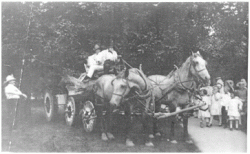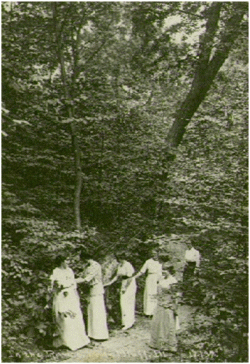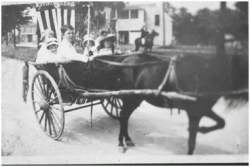1911, the first Parade
By the Way: Along the Lake Bluff Parade Route in 1911
Images provided by the Lake Bluff History Museum and Archivist Lyndy Jensen
Text (prepared in 2010) by Elmer Vliet and Carol Gilbert
http://www.lakebluffhistory.org
By 1911, the year of Lake Bluff’s first community-wide parade, Chicago was celebrating its second “Sane 4th”, Washington D.C. celebrated its third. The Chicago Tribune described the 4th of July this way:
“Ten years ago it was a fest for the rowdy and lawless. The day taught children as much about lawlessness and rowdyism as 364 days of church and family influence could unteach. The new style fourth is the old style fourth.
(From “Sane 4th to Mark New Era” June12, 1912)
By modern measures Lake Bluff was still very rural in 1911. The building booms that followed the world wars of the 20th century were still quite distant from pastoral village life. The population was 726 in 1910, and though there were a couple commuter train lines to the big city of Chicago, our marshal was chasing down those new-fangled autos with a bicycle.
Lake Bluff’s renowned Camp Meeting Association was encountering development pressures. Though the Chautauqua movement was on the rise in other locations, Lake Bluff was on its way to becoming a bedroom suburb. Lake Bluff became a village in 1895, accommodating a gradual change from summer resort to year-round residencies.
In 1909 Village President Howard asked residents to spruce up their property and trim their lawns for the holiday. Encouraged by village residents’ enthusiasm for the 4th of July, an all-day celebration was decreed in 1911.Several parade directors were named and additional committees were formed for athletics, refreshments, and entertainment.
The words ‘Fourth of July’ conjure up a kaleidoscope of memories for anyone who has lived in Lake Bluff … It means flags everywhere, family reunions, marching bands, picnic lunches on the beach, and fireworks arching across the sky. “Elmer Vliet wrote these words in 1985, in his book Lake Bluff The First 100 Years. The first parade in 1911 stepped off at 8:30a.m, and by a circuitous path, it marched to the Lake Front Park,at the east ends of Prospect and Ravine, where the village’s first gazebo stood.
A banner at the bottom of the 1911 parade program said “All Citizens are Urged to Join in the Parade”. The column of Citizens in Line were invited to join the procession just before the Carriages, Wagons, Autos at the rear. The parade was led by the police chief although usually pulled by the firefighters, the fire cart was horse-drawn for the 1911 parade, and driven by a man decked out in an Uncle Sam outfit.
Quoting the Lake Bluff Chat, Elmer Vliet wrote “Although the temperature rose to 110 degrees in the shade, ‘the sun did not equal the white heat of enthusiasm met with everywhere’ according to the Chat. ‘Did you notice’, it asked, ‘that it was the fire-laddies that always got the glad hand all along the line?'”. Fire Chief Helming rode on the back step of the hose reel, in his white helmet.The cart and hose reel were the only firefighting equipment until 1917 when a truck was donated, even so bucket brigades remained typical.
The Lake Bluff Woman’s Club started the “Lake Bluff Chat” in 1908 to give the village a local paper. It was published weekly until 1916, thanks especially to Isabelle Ross, who was reporter, editor, advertising salesman, and pressman at the end. Reporting on the first 4th, the Chat said, “A quiet, steady, irresistible getting together of new, old, and hitherto untried qualities and personalities was the thing that made us hold our breath until the affair was a thing accomplished.”
In 1911 the athletic events on the 4th began at 11:30. There were footraces for boys and girls, and men and women, including the “Tub Race, free for all” and the “Fat Men’s Race, or 200 yd. Dash”. Swimming races preceded Lunch on the Beach at 6:30p.m., followed by “Campfireon the Beach.”Fireworks were launched from the pier until a storm finished it off in 1930.
Heartened by the success of the 1911 Fourth of July Celebration, the organizers met two weeks later to create the Lake Bluff Welfare Association. Their enthusiasm led them to promote civic improvements, and they prompted the village board to establish the southern ravine as a botanical garden. Creation of the village green was next on their agenda; they purchased the land and removed several commercial buildings.
The parade and ceremonies of 1911 were so popularthat President Howard declared “Whereas, a large number of the residents of Lake Bluff have expressed a wish to properly celebrate July4th, 1912… I hereby request that all citizens join in the observance of the day.”A Director General for the Day and Evening was appointed.
Scranton Avenue must have been very festive when the floats lined up for the first parade, facing west. The parade route was a corkscrew pattern that passed through much of the little town: East on Center Avenue, South on Evanston, East on Prospect, North on Sheridan(which is now called Moffett), West on North Avenue, South on Evanston to Center again, and East to Lake Front Park. This photoshows a pony cart labeled “Future Citizens”. The Village Market building is in the background on the left.
The Village Market building was built around 1900, on the northwest corner of Scranton and Walnut, and has been a popular destination ever since. Originally known as Rosenthal Groceries and Meat Market, the store’s original frame building was torn down. It was downtown Lake Bluff’s first brick building in an era when the risk of fire was fearsome.
The Merchant Block, built in 1902,stood on the Southeast corner of Scranton and Center.It had a grocer and a drug store on the main floor. Above there were a few offices and a big room, which the village rented for board meetings until Village Hall was built in 1905. Fire completely destroyed the Merchant Building in 1917.The building that now houses Inovasi was built in 1925.
Village Hall was built in 1905. The original hose tower was taken down in disrepair in the 30’s, andrestoredduring the 1995 addition, in honor of the Village Centennial. The fire department, village clerk, village marshal and two jail cells were on the first floor. Upstairs was a new council chamber and meeting room, with a speaking tube downto the clerk’s office.
This map was drawn in 1890, before the village incorporated. The lots flanking Prospect and the ravine are quite small because they were originally platted as tent sites or tiny cottages built for the Camp Meeting Association’s summer season. The oval shown near the bottom right of the map is the location of the 2500 person wooden tabernacle, gone by 1911. The adjacent block with the I-shaped building is the 500-guest Irving Hotel which burned in 1897. Many of the lots shown here were not yet improved.
The 1913 parade program, rather cheekily, featured a firecracker. The events on the bluff and beach after the early parades must have been very popular, because by 1913 the parade floats lined up in front of the Scranton Avenue shops facing West, marched South “round the bend” on Center Avenue past Village Hall, and headed straight East to the fun events at Lake Front Park.
The Village Marshal again led the parade in 1913, and the Automobiles and Carriages again brought up the rear. Naval Cadets from the new Great Lakes Training Station marched, and the Grand Army Men now rode grandly indeed, considering the year, in automobiles. The Suffragist Floatwas a new entry since the first parade. The Chicago parade had denied a spot to the Suffragists, who retorted their point was proved entirely. Lake Bluff’s activists had no such trouble.
1913’s parade started at 1:30. The 2:30 Lake Front program featured songs by an octet, quartette, the Boy’s Glee Club, and the audience. The Naval Cadets performed drills. The Boy Scouts’ handicrafts were admired. Nine “Fancy Dances” were accompanied by violin and piano. Athletics on the beach were followed by picnics.Caverly’s Military Band of 14 Pieces played at 7:30pm, and again during the fireworks at 9pm.
Conscious of the village’s change from a summer resort to permanent residencies, the 1914 Independence Day brochure toutedThe Village Beautiful, where “Shore and shaded road, in whose arrangement the great architect and the hand of man combine, invite you to health and happiness.” The estates we now call Tangley Oaks (Armour house), Stonebridge (Kelley house)and Crabtree Farm (Durand farm)were pictured. The brochure also included photos of the lakefront’s “Mansion Row”, homes built for the very famous like Clow, Sprague, and Field.
The 1914 program also featured some homes for the not-so-famous, too, “with all modern improvements”.The Welfare Association proudly advertised their “Comprehensive Park System, from depot thru South Ravine along Lake Front, and thru North Ravine back to Sheridan Road”.The program listed seventeen reasons to live year-round in The Village Beautiful. Smallpox and typhus were killers in the early 20th century; the number one reason promised “Absolutely pure water in abundance from three wells.”
On July 9th 1914 the Chat reported, “Beginning with the Firemen’s entertainment on the evening of July 3rd everything went with a zip that was good to see.”The “shot heard round the world”that started World War I had already been fired, but the US was emphatically neutral. The Country Club’s social calendar of minstrel shows andmoving pictures continued. The glee club included lead tenor Raymond Moore, a Lake Bluff orphan who served asthe high school’s Superintendant for 30 years.
A careful look at downtown Lake Bluff in this sketch shows the electric trolley station, and the dip in Sheridan Road that slowed down Great Lakes Commander Moffett. He brought in naval designers to change that, and achieved a terrifying 60mph through town. The building on the far left is East School. The Field estate is at the bottom of the drawing. At the bottom right is the Southwest corner of Lake Front Park, where the events after the parade were held. At the top are the farm buildings of Grace Durand’s dairy, also know as Crabtree Farm.
The Lake Bluff Country Clubwas on the parade route,at the Northeast corner of Scranton and Oak. The clubhouse had bowling alleys on the first floor and a large room above for dances, concerts and stage shows. The Club was the center of society life in the early years of the Village. The passing of the old summer resort families and the formation of the Park District in 1925, contributed to the demise of the Club, and it was torn down in 1928.
Early parades passed by the Lake Bluff Orphanage. The Chicago Deaconesses Homehad rented a small house in Lake Bluff in 1894 to accommodate six children, and soon acquired the entire block bounded by Scranton, Evanston, Glen and North.The orphanagecared for 125 children in 1910. Fire destroyed the original building in 1911; all the children but one were saved. By the 1940’s the campus had grown to six brick buildings. In time, foster care replaced the orphanage system, and the buildings were taken down in 1979.
Close to the parade route is a Frank Lloyd Wright house built in 1911 in the 200 block of Prospect, which remains today. It is an example of Wright’s American System-Built House, constructed of materials prepared off-site to speed assembly. Another Wright house built in 1917 on the lakefront burned in 1956. The chimney still stands on the bluff; the rest of the remains were pushed over the edge for the lake to recycle.
By the fifth parade the Welfare Association’s festive holiday had established permanent committees like Lighting, Publicity, and Concessions, and its program now attracted paid advertising. The afternoon program in 1915featured the Navy Cadets’ Maneuvers, and the Navy Band, which gave a second concert before the fireworks. The Welfare Associationalso gave itself a pat on the back. Inside the program cover it announced, “LAKE BLUFF PROGRESSES, The Latest Step, Public Tennis Courts.”
The athletic contestsbegan at 4:15 in 1915. The prize for the Three Legged Race was Merchandise Certificates; the Greased Pole Climbing Contest offered a $5 Gold Piece; the Greased Pig Chase winner was awarded The Pig. Fireworks were on the pier, built in 1900 of enormous wooden piers that slowed the water’s southern drift, depositing sand. Lake Bluff’s beach was widest in the early years of the century. The construction of the naval harbor in 1911 changed the water’s flow significantly.
One legacy of the Camp Meeting’s cultural and spiritual convocations was the literati society that clustered in homes near Park Place, adjacent to the Lake Front Park. Among those resident in the artist’s colony was Ida Evans Haines. The programs she created for the 4th in 1915 included eight folk dances. She was active in the Travellers Aid Society, prowling Chicago depots in search of runaway girls. Wags around town said her husband spent his weekends cleaning house.
Two other residents of Lake Bluff’s artist colony gained national fame. Alice Corbin Henderson was Co-Editor of Poetry Magazine. A patriot without borders, she wrote:
“Happy is that country, therefore, which, in times of prosperity, nourishes and cherishes great poetry and great art; and happy are those poets who do not need to wait for a threatening fate to move them to song, whose spirit is at once national and individual, a realization of life in terms of immediate experience.” (June 1914 issue of Poetry Magazine)
The paintings of William Henderson, architect and painter, hang in the Art Institute.
Today’s parade route would have crossed an unreliable wooden bridge at Ravine and Moffett on the way to Artesian Park. A whopping $5 fine for dangerous speeds was posted, but until a car went into the ravine in 1915there was no action. In 1962 repairs were needed again, and a landfill was seriously considered – and rejected. When the bridge was totally rebuilt in 2006the construction was sandwiched in between parades, and now the floats march over an award-winning design.
The Lake Front Park looks very much the same as it did in 1911. The Camp Meeting Association’s motto by Wordsworth “Come forth into the light of things, Let nature be your teacher ” remains apt. The enormous oaks resident on the bluff would have shaded the pageantry in 1911, too. The beach below, though smaller, and the ravines still offer a cooler breeze on steamy days.
Today’s parade ends at Artesian Park, with little visible evidence of ever having been Artesian Lake, or the village dump until the new park district assumed control. Children
who have played in the woods at Artesian can find Swan Island; it’s the high point in the woods at the end of Prospect. East School, whose chimneys can be seen in the center background, was controversial when built in 1895 because of its location outside the campgrounds. Its fate is uncertain again.
In 1923 the Women’s Club petitioned the Village Board to create a planning commission, “believing it to be for the betterment of the community”. There had been 30 hotels in the 1880’s, well within the memory of village residents, and the changes in those 40 years were extreme. The population growth in the post-war years had accelerated, and annexations that would increase the village from one square mile to nine were being considered. These photos were commissioned as a record of the village in 1925.
When Lake Bluff presented its first community-wide parade in 1911, it did indeed celebrate without the “din and carnage” of the “insane 4th”.The first five parades from 1911 through 1915 were so popular that the tradition has marched on through war and peace alike, and the Centennial downpour of the Village’s Anniversary in 1995. When the US joined the European conflict in 1917 an era ended.
Though our modern floats do not always strive to be dignified, Lake Bluff’s parade, and the commemoration of our nation’s birth have continued for nigh a century. In 2009, a recession year, residential donations to the parade committee were higher than ever before. This year, in 2010, “100 Parades” will have will have stepped off, passed by a thousand curbside parties, and entertained nearly a million spectators.
Just in case you were wondering: How can 2010 be the 100th parade if the first was in 1911? If parade #1 was in 1911, parade #2 in 1912, and so on… parade #10 would have occurred in 1920. Therefore 2010 is the 100th parade, and 2011 will be the 100th anniversary of the first parade. You can count on it.














